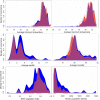The role of heterogenous environmental conditions in shaping the spatiotemporal distribution of competing Aedes mosquitoes in Panama: implications for the landscape of arboviral disease transmission
- PMID: 34776763
- PMCID: PMC8550678
- DOI: 10.1007/s10530-021-02482-y
The role of heterogenous environmental conditions in shaping the spatiotemporal distribution of competing Aedes mosquitoes in Panama: implications for the landscape of arboviral disease transmission
Abstract
Monitoring the invasion process of the Asian tiger mosquito Aedes albopictus and its interaction with the contender Aedes aegypti, is critical to prevent and control the arthropod-borne viruses (i.e., Arboviruses) they transmit to humans. Generally, the superior ecological competitor Ae. albopictus displaces Ae. aegypti from most geographic areas, with the combining factors of biology and environment influencing the competitive outcome. Nonetheless, detailed studies asserting displacement come largely from sub-tropical areas, with relatively less effort being made in tropical environments, including no comprehensive research about Aedes biological interactions in Mesoamerica. Here, we examine contemporary and historical mosquito surveillance data to assess the role of shifting abiotic conditions in shaping the spatiotemporal distribution of competing Aedes species in the Republic of Panama. In accordance with prior studies, we show that Ae. albopictus has displaced Ae. aegypti under suboptimal wet tropical climate conditions and more vegetated environments within the southwestern Azuero Peninsula. Conversely, in the eastern Azuero Peninsula, Ae. aegypti persists with Ae. albopictus under optimal niche conditions in a dry and more seasonal tropical climate. While species displacement was stable over the course of two years, the presence of both species generally appears to fluctuate in tandem in areas of coexistence. Aedes albopictus was always more frequently found and abundant regardless of location and climatic season. The heterogenous environmental conditions of Panama shape the competitive outcome and micro-geographic distribution of Aedes mosquitoes, with potential consequences for the transmission dynamics of urban and sylvatic zoonotic diseases.
Supplementary information: The online version of this article (10.1007/s10530-021-02482-y).
Keywords: Aedes mosquitoes; Arbovirus transmission; Ecological niche; Environmental gradient; Geographic species displacement; Interspecific competition; Panama.
© The Author(s) 2021.
Conflict of interest statement
Conflict of interestThe authors received funding from The Edward M. and Jeanne C. Kashian Family Foundation Inc., and Nicholas Logothetis of Chartwell Consulting. There are no patents, products in development or marketed products associated with this research to declare.
Figures





Similar articles
-
Mapping the global potential distributions of two arboviral vectors Aedes aegypti and Ae. albopictus under changing climate.PLoS One. 2018 Dec 31;13(12):e0210122. doi: 10.1371/journal.pone.0210122. eCollection 2018. PLoS One. 2018. PMID: 30596764 Free PMC article.
-
Vector competence of Aedes aegypti, Aedes albopictus, and Culex quinquefasciatus mosquitoes for Mayaro virus.PLoS Negl Trop Dis. 2020 Apr 14;14(4):e0007518. doi: 10.1371/journal.pntd.0007518. eCollection 2020 Apr. PLoS Negl Trop Dis. 2020. PMID: 32287269 Free PMC article.
-
Spatial and temporal patterns of abundance of Aedes aegypti L. (Stegomyia aegypti) and Aedes albopictus (Skuse) [Stegomyia albopictus (Skuse)] in southern Florida.Med Vet Entomol. 2013 Dec;27(4):421-9. doi: 10.1111/mve.12000. Epub 2012 Dec 27. Med Vet Entomol. 2013. PMID: 23278304
-
Globe-Trotting Aedes aegypti and Aedes albopictus: Risk Factors for Arbovirus Pandemics.Vector Borne Zoonotic Dis. 2020 Feb;20(2):71-81. doi: 10.1089/vbz.2019.2486. Epub 2019 Sep 26. Vector Borne Zoonotic Dis. 2020. PMID: 31556813 Free PMC article. Review.
-
Aedes aegypti and Aedes albopictus (Diptera: Culicidae) ecology, biology, behaviour, and implications on arbovirus transmission in Thailand: Review.One Health. 2023 Apr 30;16:100555. doi: 10.1016/j.onehlt.2023.100555. eCollection 2023 Jun. One Health. 2023. PMID: 37363263 Free PMC article. Review.
Cited by
-
A systematic review of climate-change driven range shifts in mosquito vectors.bioRxiv [Preprint]. 2025 Mar 28:2025.03.25.645279. doi: 10.1101/2025.03.25.645279. bioRxiv. 2025. PMID: 40196676 Free PMC article. Preprint.
-
Using compartmental models and Particle Swarm Optimization to assess Dengue basic reproduction number R 0 for the Republic of Panama in the 1999-2022 period.Heliyon. 2023 Apr 13;9(4):e15424. doi: 10.1016/j.heliyon.2023.e15424. eCollection 2023 Apr. Heliyon. 2023. PMID: 37128312 Free PMC article.
-
Widespread geographic distribution of Aedes aegypti (Diptera: Culicidae) kdr variants in Panama.J Med Entomol. 2024 Nov 14;61(6):1448-1458. doi: 10.1093/jme/tjae115. J Med Entomol. 2024. PMID: 39259661
-
Proceedings from the Fourth Mesoamerican Symposium "Dr. Roberto Navarro López" on Emerging Zoonotic Disease and Arboviruses: Commenting Insights and Research Findings.Res Rep Trop Med. 2025 Jul 31;16:65-89. doi: 10.2147/RRTM.S512767. eCollection 2025. Res Rep Trop Med. 2025. PMID: 40771869 Free PMC article.
-
Metagenomic Analysis of Togaviridae in Mosquito Viromes Isolated From Yunnan Province in China Reveals Genes from Chikungunya and Ross River Viruses.Front Cell Infect Microbiol. 2022 Feb 11;12:849662. doi: 10.3389/fcimb.2022.849662. eCollection 2022. Front Cell Infect Microbiol. 2022. PMID: 35223559 Free PMC article.
References
-
- Alarcón ÉP, Segura ÁM, Rúa-Uribe G, Parra-Henao G (2014) Evaluación de ovitrampas para vigilancia y control de Aedes aegypti en dos centros urbanos del Urabá antioqueño. Biomédica - PubMed
-
- Allouche O, Tsoar A, Kadmon R. Assessing the accuracy of species distribution models: prevalence, kappa and the true skill statistic (TSS) J Appl Ecol. 2006;43:1223–1232.
-
- Bagny Beilhe L, Arnoux S, Delatte H, Lajoie G, Fontenille D (2012) Spread of invasive Aedes albopictus and decline of resident Aedes aegypti in urban areas of Mayotte 2007–2010. Biol. Invasions. p 14
-
- Bargielowski I, Carrasquilla MC, Nishimura N, Lounibos LP. Coexistence of Aedes aegypti and Aedes albopictus (Diptera: Culicidae) in peninsular Florida two decades after competitive displacements. J Med Entomol. 2016;53:1385–1390. - PubMed
Grants and funding
LinkOut - more resources
Full Text Sources
